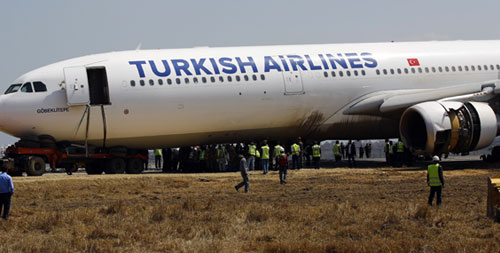Negligence of flight crew caused Turkish crash-landing at TIA: Probe panel
KATHMANDU: More than seven months after the crash-landing of Turkish Airlines airbus at Tribhuvan International Airport in Kathmandu, the high-level investigation commission has revealed that the probable cause of the accident was the decision of the flight crew to continue approach and landing below the minima with inadequate visual reference as well as not to perform a missed approach in accordance to the published approach procedure.
Submitting a final investigation report to the Minister of Culture, Tourism and Civil Aviation Kripasur Sherpa on Thursday, the panel-led by former MoCTCA Secretary Nagendra Prasad Ghimire stated that other contributing factors of the accident were probable fixation of the flight crew to land at Kathmandu, and the deterioration of weather conditions that resulted in fog over the airport, reducing the visibility below the required minima.
The commission also made 21 safety recommendations for advancement of aviation safety. “The operator should review the pilot qualification requirements to operate to and from TIA while it must ensure that the crew strictly adheres to the Standard State Instrument Arrival procedures and Airlines Standard Operating Procedures.”
The operator must ensure that the correct navigation data are uploaded on navigation database of the aircraft while it should have a system in place to act efficiently and effectively with full understanding of its gravity upon receiving the information of operational significance such as notice to airmen and feedback of the crew among others, the report added.
The operator has been recommended to establish a system of verifying the quality of charts prepared by the service provider as well as a system of checking the validity of flight management system database.
The Met Office should have a system of providing met observations immediately after the accident while CAAN must ensure that Air Traffic Controllers on duty at Kathmandu Tower are vigilant and weather information representing deterioration in visibility minima are provided through them to the aircraft immediately, the panel urged.
For this, immediately restoring Automatic Terminal Information Service Communication facility and conducting refresher training to all Air Traffic Controllers at regular interval have been suggested.
On March 4, 2015, the Turkish Airlines Flight TK-726 experienced a runway excursion whilst landing at TIA at 01:59 hrs while the TK-726 was operating a scheduled passenger flight from Istanbul to Kathmandu with a total of 224 passengers with 11 crew members. During landing, the aircraft touched down the left edge of Runway 02 with the left hand main landing gear off the paved runway surface.
A brand new USD 250 million-jet was completely out from runway and lying on grass field as it suffered major damages on its nose landing gear, nose section as well as belly fairings on both sides of fuselage, left and right engines and all wheel of left main landing gear among others.
“The commission carried out thorough investigation and extensive analysis of the available information and evidences, statements and interviews with concerned persons, study of reports, records and documents,” MoCTCA Joint Secretary Buddhi Sagar Lamichhane, who is also the member secretary of the four-member commission, said.
According to him, the final report also presented safety recommendations to be implemented by the Civil Aviation Authority of Nepal, Turkish Airlines and Department of Hydrology and Meteorology.
In accordance with the provision of the ICAO Annex 13, French, Turkish and Singaporean investigators were also associated with this investigation, he claimed.






